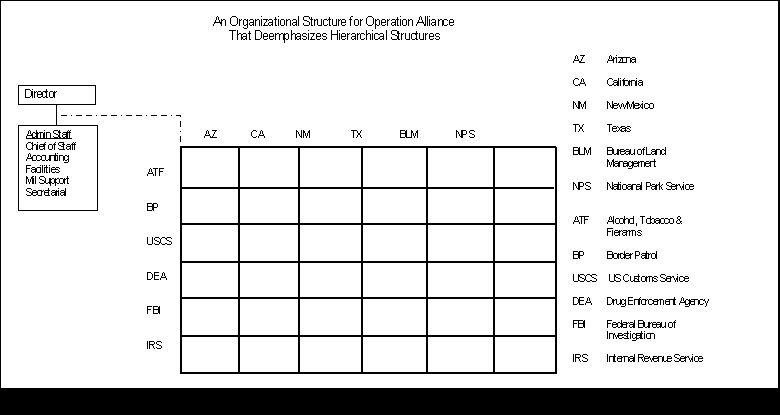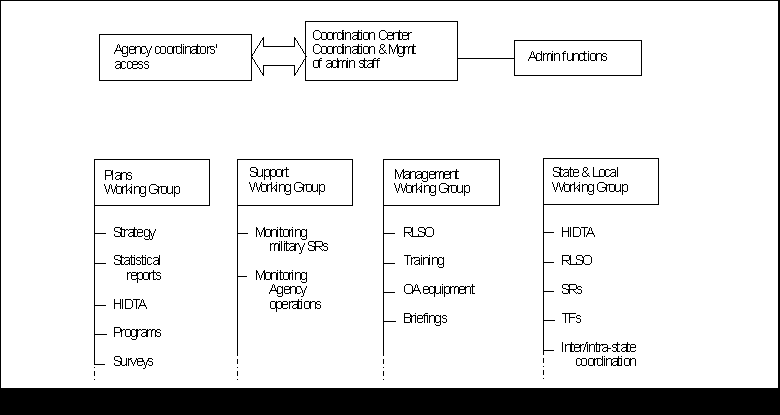
| Project Metadata | Keywords | |||||||||||||||||||||||||||||||||||||||||||||||||||
|
|
Organizational structure questions are a part of Operations Research and Management Science for which there are no pat answers. However, organizational structure plays a sometimes critical part in the operations that are being researched and changes in structure may be required.
TROUBLE IN EL PASO
Operation Alliance is headquartered in El Paso, Texas and is in the counternarcotics business. Its function is coordination and deconfliction of the counternarcotics operations of the law enforcement organizations operating in the Southwest Border area (Texas, New Mexico, Arizona, and southern California). (Deconfliction is governmentaleze for keeping the good guys shooting at the bad guys, not at other good guys, sometimes literally.) There are more than 20 federal agencies with roles relating to counternarcotics operating in the Southwest Border Area, not to mention all of the state and local agencies! The internal dynamics of Operation Alliance had become somewhat dysfunctional and we (the Data Systems Research and Development Program of the Department of Energy Oak Ridge Facilities) were asked to help them find and fix the problem or problems.
We were already somewhat familiar with Operation Alliance from other work we had been doing and felt confident that we could help. We proceeded to perform a "management study." What this actually involved was interviewing everybody in the Operation Alliance Coordination Center in El Paso and everybody in its steering committee, called the Joint Command Group. We used a semi-structured methodology. That is, we had some preconceptions of the nature of the problems and asked questions to draw responses in those areas and asked other open-ended questions to discover other problems. We also omitted the structured questions in a random sample. (That is, some people were so talkative that we never got to our list of questions.)
Following the interviews, we collated the results and analyzed them. (Translation: we counted the "yes," "no," and "maybe" responses for each potential problem, both original and discovered.) We then developed alternative courses of action and selected our recommendation for the best choice for each significant problem. (Significance was based on number of people who considered it a problem and their vehemence.)
LINES OF AUTHORITY
At this point, one might expect that we presented the results and were applauded for our brilliance or were shot down in flames. However, we were too smart to present the materials cold; we discussed our results with those in power prior to the formal presentation. The presentation went very well.
You may have noticed that I have very carefully avoided giving any details up to this point. Most of the details are not germane to the point of this tale. The point has to do with preconceptions and the need for flexibility of thought and the value of working closely with the customer. The component upon which I will focus is the problem of the organizational structure of Operation Alliance.
Prior to asking for our help, Operation Alliance had made several attempts do define a charter for itself and develop a concept of operations. It had also successfully produced two editions of a strategic plan for counternarcotics operations in the Southwest Border Area, based on the National Drug Control Policies. These efforts spanned two to three years and generated a considerable volume of paper, all of which we examined prior to beginning the interviews. Among this paper were several attempts at organizational charts for Operation Alliance, one of which is reproduced below.

Figure 2. Old Organization Chart
As you can see, it looks much like any other organizational chart, with function boxes, occupied by people and lines connecting them. We believed the charts reflected the current structure and that if changes were needed, the changes were changes to some version of this structure. The complaints we received in the interviews concerned decisions made without the interviewee's input, closed-door meetings, control of the power being reserved for certain agencies, and remarks in a similar vein. These remarks appeared to confirm that something was wrong with the organizational structure.
At this point, you need to know more about the makeup of Operation Alliance. The staff in El Paso are agents of twelve federal law enforcement agencies and representatives for the four states' state and local law enforcement agencies. Operation Alliance is not a federal agency or a federal organization; it is an alliance of agencies with representatives working together. No representative of one agency works for a representative of another agency. We discovered that the lines on the organizational chart, which normally imply lines of authority, did not exist! The organizational charts were phantoms. The representatives who had titles appearing to confer superior authority had no more authority within the organization than any other representative.
As we ruminated on the results of the interviews, we discussed options. We had been told that it would be impossible to convert the organizational charts to reality because no agency would permit another agency representative to write an annual performance appraisal on its personnel. Being familiar with joint military organizations, in which the analogous situation was permitted, we had asked for confirmation. We were assured that the joint organization of the military was by act of Congress and had taken many years to be fully accepted. A similar act of Congress would be required in the law enforcement world and would take a similar period for acceptance. Despite this assurance, we discovered a joint law enforcement organization within a mile from the Coordination Center, in which representatives of various agencies were truly subordinate to someone of another agency. We concluded that such a situation was an option, although difficult to achieve.
ERASING THE LINES
In our discussions with politically knowledgeable people, we decided that we needed a more immediately achievable solution. We hit upon the concept of making everyone a vice-president (or the equivalent superior sounding title) and emphasizing the coordinating aspects of the relationships among the representatives at Operation Alliance. We decided that the easiest method of presenting this concept was to draw the organization as a matrix organization. One pair of useful dimensions was functional jurisdiction (such as border patrol vs. alcohol, tobacco, and firearms) and geographical jurisdiction (such as state jurisdiction and federal land jurisdiction). We then described this as representative of all of the possible interactions. We used the chart shown below. (One other result of the study, prominent in the chart below, was the recommendation that a common staff be hired for the use of all representatives, some of whom were not funded to support a separate secretary.) Note that the Director is connected by dotted line to the matrix, indicating that even the Director would not have full authority over anyone except the staff.

Figure 2. Proposed Organization Chart
We were satisfied that this organizational description fit the situation and would alleviate some of the problems. We presented our results and were thanked for our efforts. We expected that all we would be asked to do beyond the presentation would be to complete the write up in final form.
A FAILURE TO COMMUNICATE
To our surprise, we were called and asked to return and facilitate a working group's efforts to develop an implementation plan and implement the proposals. It was here that our flexibility and ability to work closely (listen) to the customer was tested. We were very gratified to discover that the working group was taking our recommendations seriously, as evidenced by the work they had done prior to our arrival; however, we were distressed by their apparent disregard for the fact that no one had authority over anyone else, as evidenced by an organization chart that looked much like their old attempts!
That first impression was the correct one. During the course of a day, the working group proceeded to address each problem that we had identified and either worked out a solution, an acceptable compromise, or a phased approach to the problem. We also resolved the problem of the lines on the organization chart - we removed them.
What we had missed in our interview process was the real need for smaller groups within the Coordination Center to work on standard tasks, such as the requests from law enforcement agencies for military support. The ad hoc working group arrived at the solution of creating standing working groups or committees, each with a set of tasks. One of these working groups was to address problems that impacted the states and local agencies. This created a leadership position for a state/local representative, who had heretofore been left out of the leadership roles. The old organization had contained a rotation procedure for the senior position; however, only three agencies participated in this rotation. The new plan added a rotating working group chair position to empower the other federal agencies. The chart below shows the resulting organization chart.

Figure 3. Final Organization Chart
Various other procedures were defined to address the real and perceived inequities in the previous structure. The defining concept for the organization is that of the committee structure of a volunteer organization, such as the Operations Research Society of America. No one can be forced to perform work; however, work needs to be done. The Working Group Coordinators (chairs) are responsible for reminding/prodding/nagging the members into accomplishing the group's goals. The Coordination Center Coordinator is responsible for doing the same to the Working Group Coordinators. However, note that each agency coordinator has free access to the center coordinator and he or she to them. This is not a military line organization with a chain of command.
It developed that the process of responding to the problems identified in the management study was sufficient to define a charter and a concept of operations. The ad hoc working group was able to convert the solutions into a charter document in a single day. The test of this work lay in its acceptance (with minor changes) by the entire Coordination Center and the Joint Command Group.
CONCLUSION
Few operations research projects will have this organizational structure as a solution. However, most operations research projects require a willingness to abandon preconceptions and maintain a flexible attitude toward early "solutions." After all, if the solution were clear, most of the reasons for having an operations research project are missing. Likewise, most operations research projects require close attention to the customer. Very often the project solution is to draw the problem solution from the customer, because the customer's people are the experts in the complete situation. A key to the solution of this problem was writing down what was said and then agreeing (or disagreeing) during the same meeting, avoiding a long drawn out process.
This project was brought to a successful conclusion and has been implemented. The solution is likely to continue to work because the people of Operation Alliance are dedicated to the goals of Operation Alliance and want to make it work. However, as with all organizations, personnel change over time and the environment changes bringing new stresses. In the parts of the solution that weren't addressed here, there are mechanisms to permit evolution; however, this is no guarantee that they will be used. Organizational problems don't permit permanent, fixed solutions.
If you arrived here using a keyword shortcut, you may use your browser's "back" key to return to the keyword distribution page.
Return to Hartley's Projects Page